FREE Uber Tax Info Pack
FREE 5-Day Email Course to learn the ATO’s Uber tax rules
FREE Uber Expense Spreadsheet so you never miss a deduction
FREE Uber Logbook Spreadsheet to claim your car expenses
FREE ABN & GST Registration (if you need it!)
FREE Uber Tax Info Pack
> FREE 5-Day ‘Uber Tax Essentials’ eCourse
> FREE Uber Bookkeeping Spreadsheet
> FREE Uber Logbook Spreadsheet
> FREE ABN & GST Registration
Saving For Your Uber Tax Bill
Last updated 7th June 2024
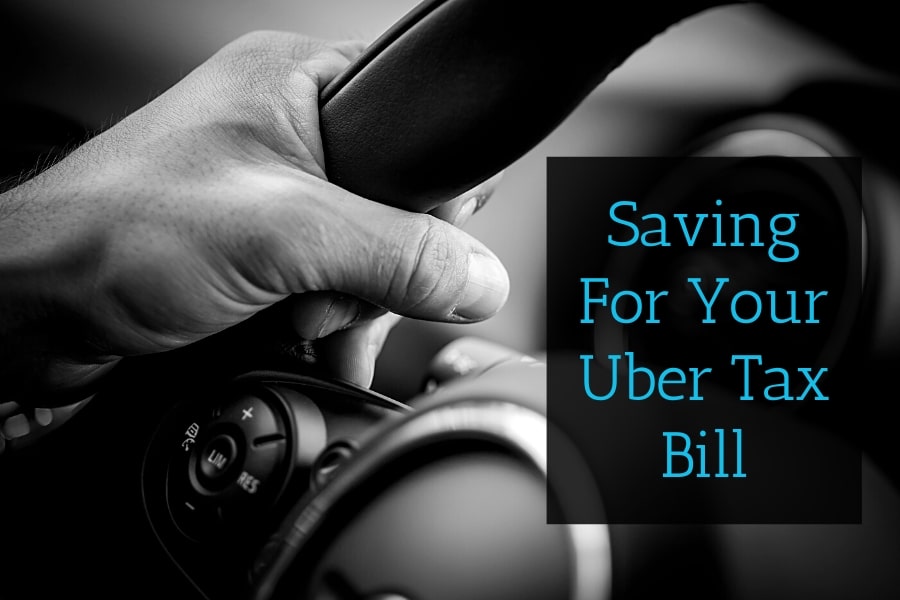 Tax is an unavoidable part of being in business. But putting aside savings for your Uber tax bill can be a slippery slope.
Tax is an unavoidable part of being in business. But putting aside savings for your Uber tax bill can be a slippery slope.
It can be challenging to figure out how much tax to put aside from your Uber income, and too often people find themselves in trouble with the ATO after tax bills accumulate. A set routine for putting aside tax as you go is essential to avoid any tax-time panic.
This can be tough, as it’s easy to feel pressured by your other bills and expenses. Once you fall behind you’ll find yourself continually playing catch-up.
This article will help you work out how much tax to put aside from your Uber income, and the best methods of saving for your tax bill, so that you can head into tax time feeling confident.
Saving For Your Uber GST Bill
The Rule of Thumb Method
The easiest way to work out how much you should put aside for your Uber GST bill is to work on a ‘rule of thumb’ percentage, and put this aside whenever you get paid.
From processing thousands of Uber BAS’s, we’ve found that on average your Uber GST bill will be roughly 5%-8% of your Net Uber income (i.e. the amount you receive in your bank account from Uber).
Once you’ve lodged your first BAS or two, you can calculate your actual percentage, rather than relying on our generalisations. Take your GST bill for the quarter, and divide it by your net Uber income for the quarter as per your bank statements, and this will give you your percentage. (Be sure to use a ‘normal’ quarter, not one where you had a car purchase or unusually high income or expenses)
The Manual Calculation Method
If you’re not a fan of the percentage method and would prefer to work out exactly how much you need to put aside, you’ll need to actively keep track of your income and expenses each week with a spreadsheet. You’ll need to set up formulas to calculate your GST as follows:
- Gross Income (Fares before Uber’s commission is deducted)
- divided by 11
- = GST on Income
- less: GST on Uber Fees (including split fare fees, booking fees and other amounts they deduct from your fares)
- less: GST on Vehicle Expenses multiplied by your percentage of business use
- less: GST on Other Expenses (bottles of water, mints, stationery, etc)
- = Net GST Payable
(Note that there is no GST on depreciation or loan interest, so these are not taken into account on your quarterly BAS’s).
If you’re looking for an easier option, the DriveTax Bookkeeping Spreadsheet can do all of these GST tax calculations for you. You’ll always have the correct amount of tax savings put aside, and you can easily lodge your own BAS’s if you choose. You can download a free copy as part of our free Uber Tax Info Pack.
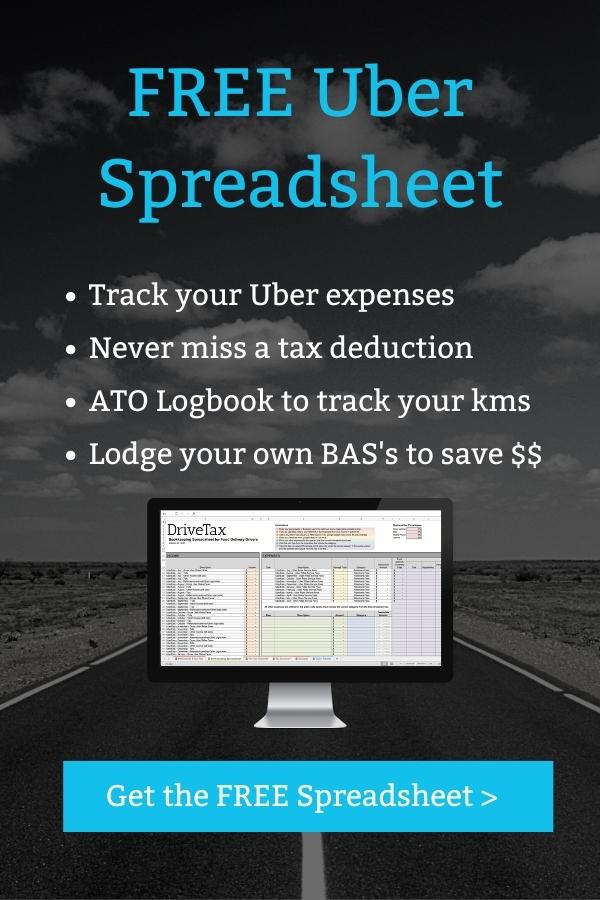
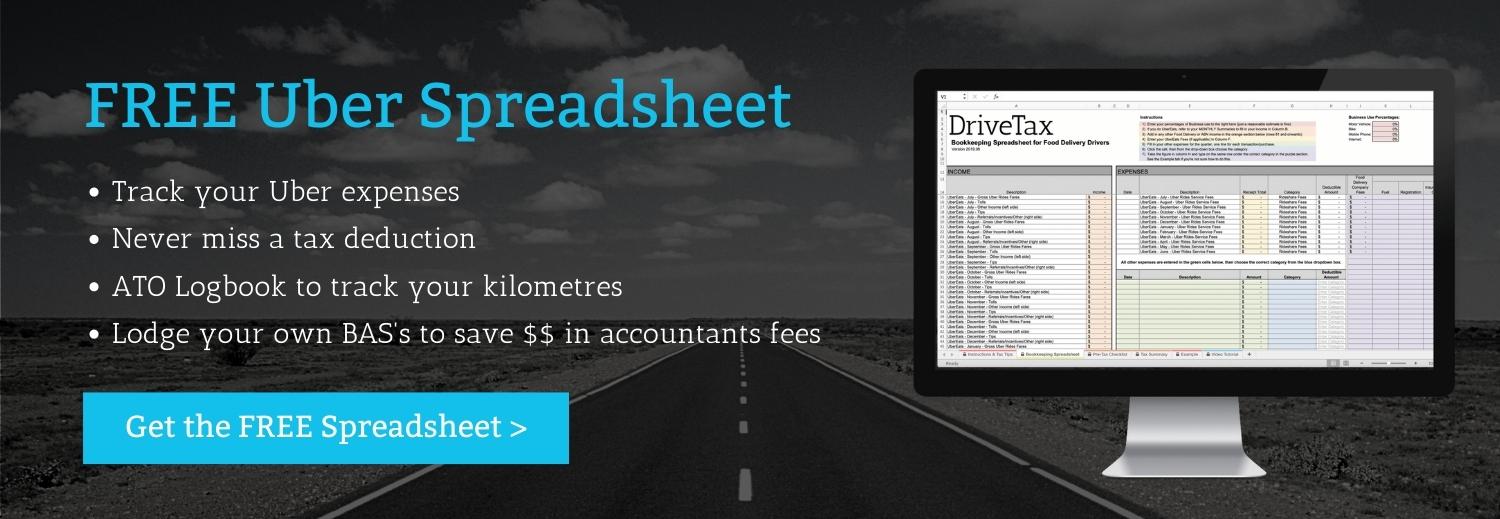
When and How do I Pay the GST?
You need to pay GST to the ATO on a quarterly basis. This is done via a Business Activity Statement (BAS). On your BAS you’ll declare your income and expenses and the GST on each of those amounts as we calculated above, and then you’ll pay the net GST amount to the ATO. For more detail on how this works, visit our Ultimate Guide to BAS for Rideshare Drivers.
Saving For Your Uber Tax Bill
How Is My Taxable Income From Uber Calculated?
The amount you’ll be required to pay tax on is calculated as follows:
- Gross Income (Fares)
- less: 1/11th GST paid to ATO
- less: Uber Fees excluding GST
- less: Vehicle Expenses excluding GST (adjusted for private use percentage)
- less: Other Expenses excluding GST (bottles of water, mints, stationery, fees & charges etc)
- = Net Taxable Income
Our Ultimate Guide to Uber Taxes explains more about how this calculation works, and our article on tax deductions for rideshare drivers contains more detail on what you can claim and how to calculate your vehicle deduction.
How Much Should I Put Aside For My Uber Tax Bill?
Similarly to GST, the best approach for putting aside income tax is to work out a ‘rule of thumb’ percentage rate that’s appropriate for your circumstances, and then put aside that percentage of your income each week. Here’s how:
- Work out what your taxable income will be aside from your rideshare driving (e.g. employment income, contracting work, investment income).
- Refer to the ATO’s tax tables to see what your marginal tax rate is (below).
- Take your Uber and other deposits from your bank account, if you’re registered for GST then divide by 1.1 to exclude the GST, and then multiply by your marginal tax rate.
- If you keep a log book, and have a reasonably high percentage of vehicle use for rideshare purposes, you might reduce your percentage by 10%
- If you have lower percentage in your logbook, or you don’t plan keep one and plan to use the cents per km method instead, reduce your percentage by 5%.
- If you prefer to be ultra-cautious and save more than necessary, you can choose not to reduce your percentage at all.
- If you usually have a high tax refund each year, perhaps due to lots of tax deductions from your main job, or negative gearing on an investment property, then you can take this into account and reduce your percentage further.
| 2023 & 2024 Financial Years | |
| Taxable Income | Marginal Tax Rate * |
| $0 – $18,200 | 0% |
| $18,201 – $45,000 | 21% |
| $45,001 – $120,000 | 34.5% |
| $120,001 – $180,000 | 39% |
| $180,001 and above | 49% |
(* these rates include the Medicare Levy)
| 2025 Financial Year | |
| Taxable Income | Marginal Tax Rate * |
| $0 – $18,200 | 0% |
| $18,201 – $45,000 | 18% |
| $45,001 – $135,000 | 32% |
| $135,001 – $190,000 | 39% |
| $190,001 and above | 49% |
(* these rates include the Medicare Levy)
Each time you get paid from driving, put that percentage aside. Your tax savings will grow, and at the end of each quarter or year when your Uber tax bill arrives, the funds will already be there, ready to go.
Setting Up a Savings Account for Uber Taxes
To keep this tax aside, set up a separate savings account especially for saving up for your tax bill. Most banks offer free ‘online only’ savings accounts that are easy to set up, earn a decent interest rate, and don’t have keycards, which is perfect for making sure you don’t touch your savings.
Once you’ve worked out what percentage of savings of your Uber earnings is right for you, all you need to do is log into your internet banking each time you get paid from Uber, and transfer your savings amount from your regular bank account to your Uber savings account. Then, when it’s time to pay your tax bill, just transfer the amount you need back into your regular bank account in order to make the payment. Easy!
Learn More About Saving For Your Uber Tax Bill
This article covers the bare essentials of saving for your Uber tax bill. If you’d like to learn more, you may be interested in our Understanding Uber Taxes online course. Through a series of 30+ video lessons and tutorials, you’ll learn exactly how to calculate your Uber tax bill, how to monitor your tax bill as you go and always save the correct amount, the FULL version of the DriveTax Bookkeeping Spreadsheet which will take care of all the tax calculations for you, video tutorials on how to lodge your own BAS’s and tax return and much more. Visit our course information page to find out more.
Thoughts? Questions? Leave a comment below and I’ll respond shortly! – Jess

About the Author – Jess Murray CPA – Uber Accountant
Jess Murray is a CPA Accountant and registered tax agent. She’s been working in personal and small business tax for 15 years, and has been specialising in tax for Australian Uber Drivers for the last 7 years as the Director of DriveTax. She also teaches an online course called Understanding Uber Taxes.
Jess is on a mission to make taxes straightforward and manageable for Uber drivers across Australia.
The information in this article is general in nature and does not take into account your personal circumstances. If you’d like to know how this article applies to you, please contact us to arrange a consultation, or talk to your accountant.


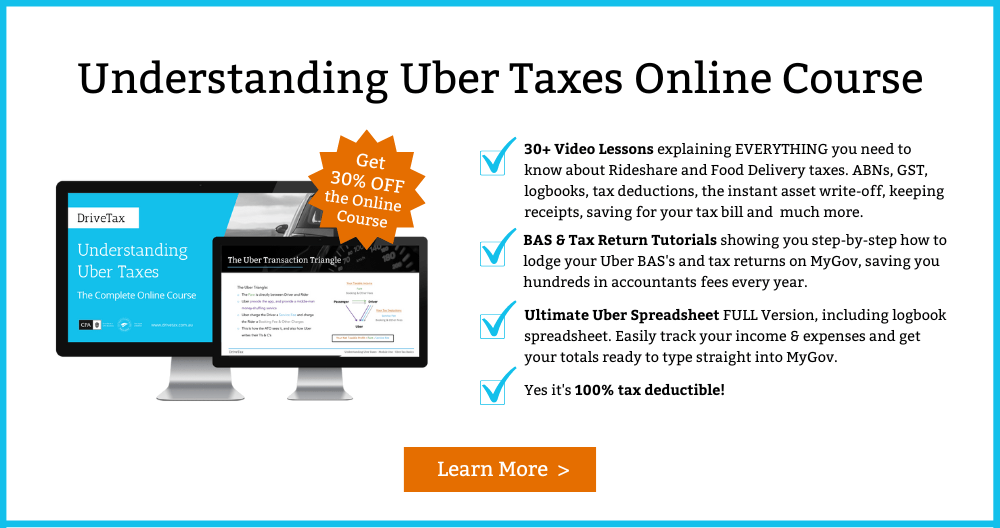
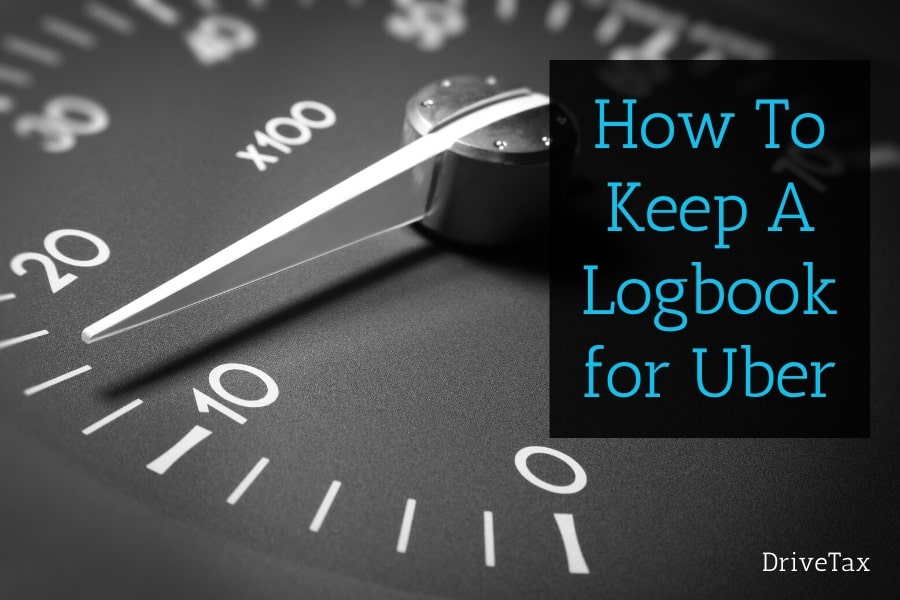
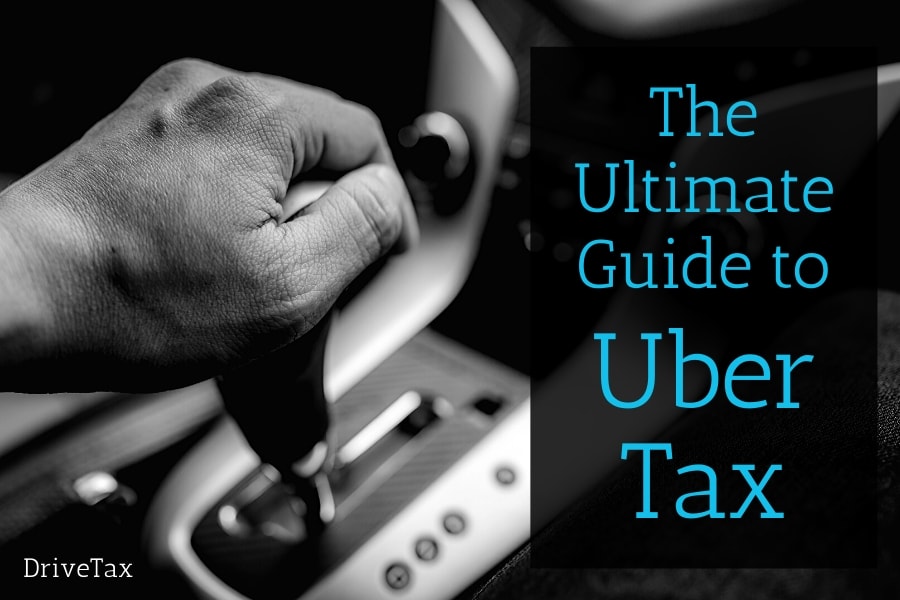
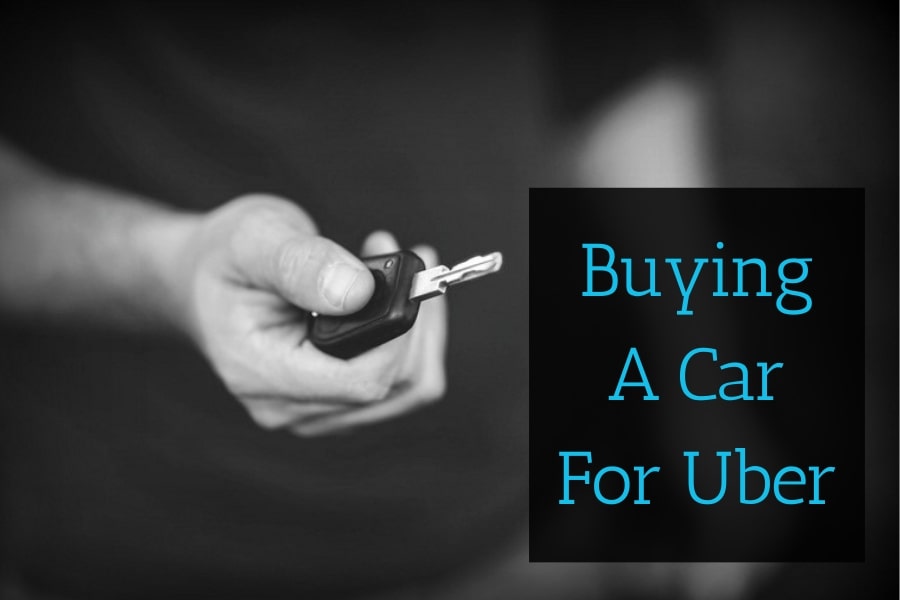
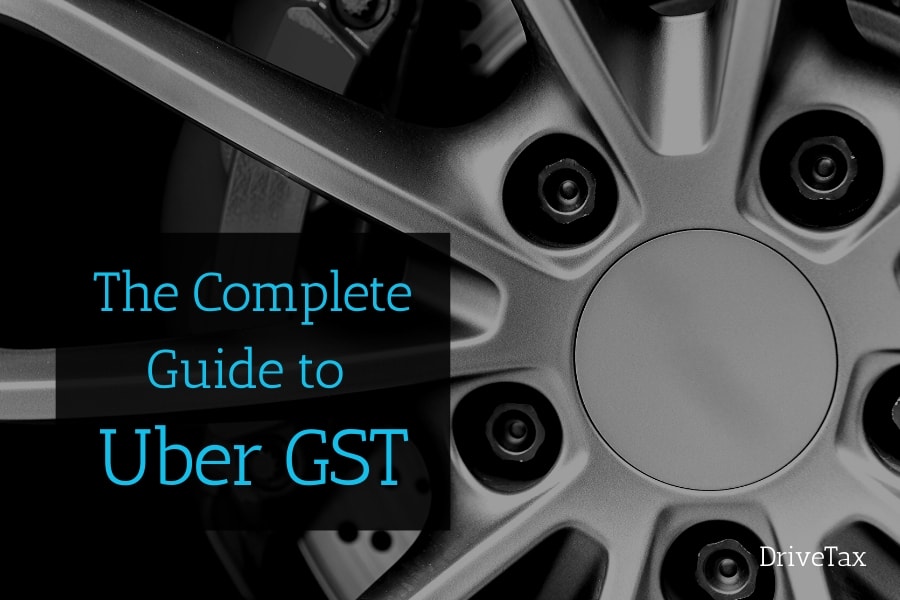
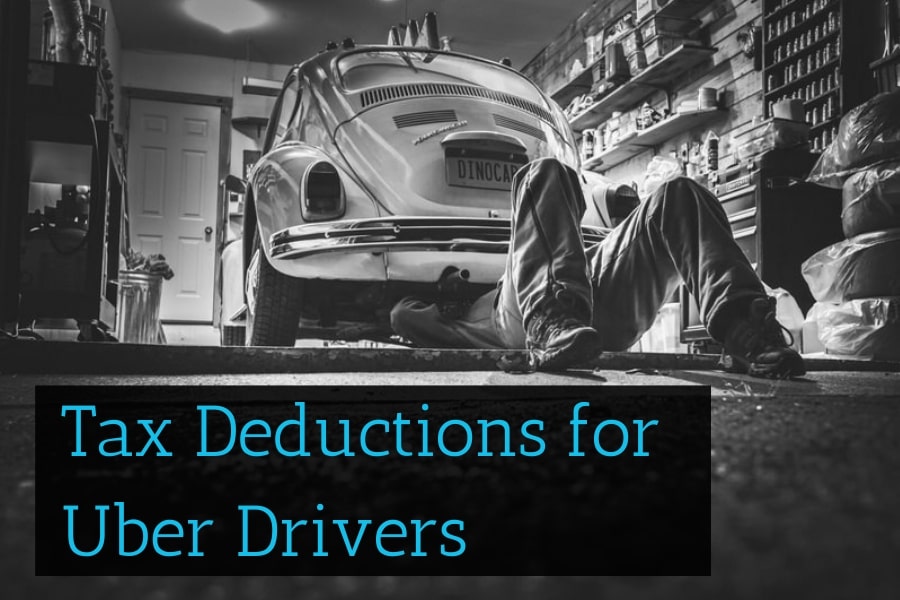
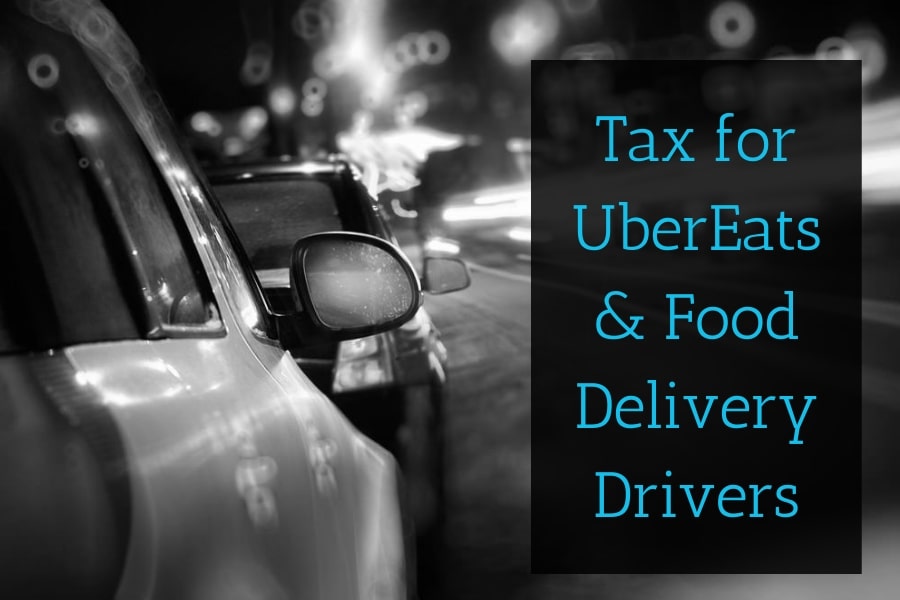
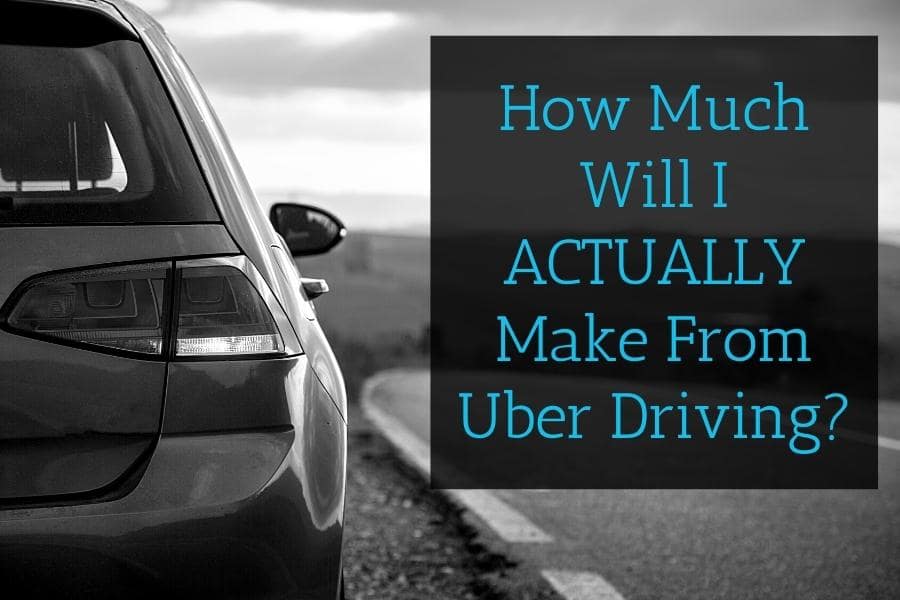
Hey Jess,
I’m thinking about taking up delivery driving as a side job, my main job automatically takes taxes out with each pay check, so I’ve got a few questions..
Do I have to worry about my main job taxes when doing them manually for delivery driving? So for example if I make 60k a year, which is taxed automatically, then say 20k a year doing deliveries, do I only need manually to do the taxes from delivery driving and can just let the employer/ato deal with the main job taxes? Or will I need to factor in the income from my main job? It’s not so bad if I only have to do them for delivering, it becomes a giant headache if I have to factor in my other income too..
Second (and final) question; am I taxed based on total combined income, or separately for each job? So basically wondering if I can make the tax free threshold while delivering or not..
Hi Corbin, both your employee income and your delivery income must be declared in your end of year tax return. For your employee income your employer will take out PAYG Withholding tax, which is essentially savings towards your end of year tax bill, whereas for delievry driving you must tdo the saving yourself. This is all covered in the blog post above. To calculate your end of year tax bill, the ATO throws both your employee income and your Uber net profit all into one ‘bucket’ of taxable income, and then they apply your marginal tax rates to determine your final tax bill. This means that your employee income affects your tax bill on your delivery income and vice versa. For more detail, I recommend reading our blog post on Tax for Uber Drivers, as well as the post above. – Jess
Hi Jess,
I find your blog very useful. Thanks for all the knowledge. I would like to know if you could explain what the ATO means by GST turnover for Uber drivers? Is it the gross amount that UBER receives from passengers or is it the Gross income that the driver receives from Uber? Should promotions from Uber and tips be included too? Thanks
Hi Daniel, actually all funds from passengers are considered the income of the driver. Then the driver pays the service fee to Uber, which is Uber’s only actual income. There is no income that goes direct from passenger to Uber. For an explanation of this, visit our blog post Uber Tax Explained.
To answer your question, your GST turnover is all the gross amounts you receive from your passengers excluding GST. You can calculate this by taking all of the Transportation Income (fares, booking fees etc) and Other Income amounts (incentives, tips etc) on your Uber Monthly Tax Summaries and dividing by 1.1 to exclude the GST. – Jess
Hi can you please clarify how much can you claim back from the uber fees or you can call it uber commission which is now 27.5%, for example gross was 41000 and my uber fees was around 9000.
What amount would be deducted from my tax?
Hi Elias, our blog post on GST on Uber Fares and Fees will answer this question. To show the calculation, $41,000 / 11 = $3,727 GST so $41,000 – $3,727 = $37,273 taxable income. Then for the expenses, $9,000 / 11 = $818 GST, so $9,000 – $818 = $8,182 tax deduction. So the net taxable income would be $37,273 – $8,182 = $29,091. A quicker way to do this calculation is ($41,000 – $9,000) / 1.1 = $29,091. – Jess
Hello Jess, Nice helpful article. If I do Uber as my only job, and earn only $18000 profit after uber 25% fee. I would pay no tax?
My goal was to earn $25000 net profit after the uber fee. (I’m not calculating any other costs like fuel, service etc) but that would leave me with around $20k after tax.
So if I only do $18000, is that more beneficial than doing $25000?
Please answer, I’ll do my tax with you :)
Shaun
Hi Shaun, you’re correct that if you earn $18,000 after expenses and have no other taxable income then you won’t pay any tax. If you earn more profit than that then you will pay a little tax. But it is always better to earn extra money and pay a little tax, than to have no money at all. To put it another way, once you cross into the 21% tax bracket, for every dollar you earn, 21 cents goes to the ATO, but 79 cents still goes in your pocket. You still have more money than if you didn’t work at all. – Jess
Hi Jess I’m an uber driver but I work for a gentleman under blackcat chauffeurs and I understand uber get 25% and we share the remaining 75% and he pays for petrol and maintenance. The question I’m asking is when I purchase items such as laptop, clothing,and other purchases do I subtract the total amount of my purchase and then pay the balance to the ATO I’m just a bit confused about it because I’m just starting out as a subcontractor and loving you website and information it has on
Kind regards Glenn Stoneham
Hi Glenn, when you fill in your BAS’s and tax return you need to separately declare your income and expenses. In other words, you enter your income in the income section, then in the expenses section you can enter your car expenses, computer expenses and any other related expenses. The BAS/tax return will then ask you to subtract your expenses from your income to give your net taxable income. It’s still the same outcome, but the ATO want to see the breakdown. Note that clothing is not deductible unless is has a logo of the company you work for. Even if you’re required to wear a black suit or other distinctive clothing that you bought especially they are not deductible, only logo items can be claimed. – Jess
This is a great post and the questions too. I’m considering signing up in a few months, but given your comment about Uber becoming Australian based am wondering if it’s better to wait.
Look forward to a update explaining the difference.
Hi Tamra, The change has already completed effective from the 1st of December 2017. There’s no need to let this delay you from joining Uber. The only difference is that they will now charge GST on the 25% service fee they charge you. However you can claim the GST back on your BAS, which means there’s no out of pocket cost or difference to you. – Jess
Hi Jess..
thanks for your wonderful support.
Quick Question.. I am working on TFN as well as Driving uber on ABN. I have not registered for GST yet but planning to apply soon. Will my uber income affect my TFN income ? I mean if I earn 15K AUD from UBER and earn less than 18K AUD from my TFN job, will I be able to claim all the tax back from TFN ?
Secondly, working on both ABN n TFN increases Tax deductible ?
Sorry, I am noob at this. Did my TFN tax returns my self but that was simple and easy. With Uber GTS, everything complicated now
Hi Muhammad,
Your Uber income and Employment/TFN income are added together to work out your end of year tax bill. So you will have tax to pay overall. If you only earn a little from your TFN job then they may not be taking tax out, so you may need to save extra from your Uber income to cover your tax bill. Your tax deductions are for money you spend while working/earning your income. So your deductions aren’t higher just because you earned more, they will be higher if you had more expenses. If you’d like personalised advice on this please feel free to book a consultation. – Jess
Hi Jess,
How do I claim my GST payments back if I earn under $75k?
HI Bradley,
The $75k limit is only used in deciding if a business must register for GST, once they go ahead and register the $75k has no further bearing, they must pay GST regardless of whether they are over or under the $75k limit.
HOWEVER the $75k does not apply to rideshare drivers. Rideshare drivers must register for GST and pay GST regardless of their turnover. The $75k limit is completely irrelevant.
– Jess
Jess… there is a section on the ATO website which deals specifically with ‘Bonus or top-up paments’. My reading of this is that Uber’s surge pricing would come under this, and would therefore not accrue gst? I have tried to clarify this with the ATO, and they seemed to be in agreement? Can you comment at all on this?
Hi Ben,
You’re right that bonus payments paid outside of Australia aren’t subject to GST, but the surge pricing doesn’t fall into this category. The surge pricing is paid to you by your riders in order to incentivise you to pick them up in busy times. The customer is in Australia and the service/activity takes place in Australia, so it is subject to GST. Remember that as per their terms and conditions, Uber is just a software platform that you use to find, charge and receive payment from riders, and all of that occurs in Australia.
The only type of Uber payment that falls in to the category of offshore ‘bonuses’ is when you receive a referral fee or incentive payment, such as signing up another Uber driver, from an overseas company*. Essentially, when you do something for a rider (i.e. anything connected to a ride) it’s GST, and when you do something for Uber directly (i.e. their marketing and promotion) it will be non GST. An easy way to tell is by looking at your monthly summaries from Uber. Anything on the left hand side is subject to GST and anything on the right hand side is GST free.
*Note that this may change from 1 Dec 2017, as Uber are changing much of their service provision to an Australian based company. We don’t have all the details yet, so keep an eye on correspondence from Uber.
Jess
Hi Jess, if I currently work part-time as a sole trader with my abn, will I pay more income tax as uber would be a second job? Thanks
Hi Scott,
Yes and no. As far as the ATO is concerned your employment and Uber income get lumped in together as one total figure, which is then taxed at marginal rates. One is not taxed higher than the other, all your income is treated the same.
However your employer is most likely claiming the tax-free threshold to themselves, meaning they are taking a lower rate of tax out of your pay to save for your end of year bill. Therefore you’ll need to put aside a higher amount of your Uber income as savings to compensate.
– Jess
Hi Jess, Uber weekly statements are showing Tax on Fee: Tax withheld by Uber on its fee?
However, in the monthly statements it does not show this.
I can sort of understand why it is not showing on the monthly statement as Uber add it into the Drivers payout
Should we be able to claim this GST fee back?
Or do we just ignore this “Tax on Fee”
HI John,
The monthly statements give the clearest picture, so we recommend using those to prepare your BAS & tax returns. You should declare all of the income in the income part of your BAS (G1 and 1A), including split fare fees, tolls and booking fees. Then, in the expenses section (G11 and 1B) you can claim these amounts as an expense as well (plus Uber Fees of course). So the net result is still zero, because of course you shouldn’t pay tax when it’s just a reimbursement, but the ATO wants to see both sides of the equation.
The ‘Tax on Fee’ amount isn’t really tax, it’s just Uber reimbursing you for the GST you’ll pay on the booking fee in the income part of your BAS. We can confirm that their method of calculating this is correct, and so by filling in your BAS the way I’ve mentioned here you will not end up out of pocket or paying any tax on reimbursed items.
– Jess
Hey Jess thanks so much for this information its been so useful for me. I drive full time and its paying all the bills but the delay for me in playing catchup with my gst and first annual tax is daunting!
If we look at the Uber “commission” as tax deductable at the end of the year, is that commission then 100% deducted from the annual income to reduce the entire taxable income….
Hi Peter,
The tax obligations are significant aren’t they? It’s frustrating that uber drivers have to get caught up in all this tax compliance when most small businesses don’t have to!
The deductibility of your Uber fees against your other taxable income depends on your scenario. Your Uber Fees are a tax deduction against your Gross Uber Income. Once you’ve claimed your Uber Fees, car costs and other business expenses, you’ll end up with either a profit or a loss.
– If you have a profit, this is taxed at your marginal tax rate.
– If you have a loss, and your Gross Uber Income (gross fares and other income items before Uber deduct their fees) is less than $20k, then you can’t claim that loss against your other taxable income. Instead the loss is carried forward, and can be offer against any Uber profits you make in future years.
– If you have a loss, and your Gross Uber Income is more than $20k, then you can claim that loss against your other taxable income.
Jess.
What about expenses incurred directly in collecting Gst for the govt. I.e. 25% commission payed/collected by uber on Gst component added to uber fare!!
So on a $1.00 Gst collected (minus 25% commission $0.25) $0.75 is net Gst collected that is owed to govt. Isn’t this a fair consideration!!!!
Hi Joseph, Thanks for your comment. I know it’s frustrating, but the ATO don’t look at it that way. In the eyes of the ATO, the gross fare is your income, and the Uber Fee is a business expense, just like fuel or mints. You have to pay GST on all of the Gross income you earn, which means before Uber deduct their fees. Then you can claim back any GST you have paid on your business expenses. There is GST on fuel, so you can claim that back, but there is no GST on Uber fees, so there is no GST to claim (because you didn’t pay any in the first place). This is the way GST works for all small businesses. It seems confusing for Uber drivers because you only receive the 75% into your bank account but you are paying GST on the whole 100%. But in the eyes of the ATO they are two separate transactions, the gross fares are your income and the Uber fee is a business expense, and that’s the way the calculate GST.
Hi Jess,
I am loving these questions! I have only started off as an ubereats driver with the thought of moving into becoming a uber driver.
As I am delivering food at the moment and not people would you suggest still getting GST registered?
Hi Amelia,
Thanks for your feedback! UberEats driver’s don’t have to register for GST, as those rules only apply to drivers who carry passengers, not food! So, should you register voluntarily? Without knowing your personal circumstances, my general answer would be no, for two reasons. Firstly, this would mean handing over 8-10% of your income to the ATO (based on an average Uber driver, after taking expenses into account), and no-one wants to pay more tax than they have to. Secondly, lodging BAS’s is a pain, and unless you DIY it will cost you extra in accounting fees. Avoiding BAS’s means one less thing on your to do list each quarter, and one less deadline to worry about. Note that if you do choose to register voluntarily you must stay registered for 12 months. I hope this helps Amelia, good luck with your driving!
Hi Jess, I am very happy with the explanations.
Currently I am working as Ubereats delivering food as well using biycle, not car.
So it means I don’t have to register ABN, GST and BAS? This also includes that I don’t have give financial year end reports? Because rules only state to drivers who carry passengers.
Hi Billy,
You’re partly correct! If you’re transporting food, not passengers, then the GST rules don’t apply, which means you don’t need to register for GST or lodge BAS’s. However, as for any small business, you must still have an ABN, keep records of your income and expenses, keep a logbook if using your car, and declare your income on your end of year tax return. I hope that clears it up for you! Keep an eye on our website and blog in the coming month for more information for food delivery drivers!
Hi Jess,
Thanks for the very useful information. How much do you charge for a consultation ?
Thanks
Charlotte
Hi,
Just a quick request for clarification:
If the GST payable is 1/11 of gross fare (inc Uber fee)… What happens if, instead of 20%, Uber charges 90% commission on the fare? In that case, out of $100 I would have to pay the ATO $9.09 from my $10 share? (I realise that this is unrealistic but I’m trying to make a point that perhaps the GST should be 1/11 of my share only?)
Your confirmation would be much appreciated.
I have a feeling that as the ATO can’t make Uber pay the GST on their 20% commission, they’re trying to collect it anyway through us drivers… True?
Hi there,
The ATO view this differently. In their eyes, the Gross Fares you earn are all your income, therefore all subject to GST. Then you can claim back the GST on all your expenses. There is GST on your fuel, so you can claim that back, but there is no GST on your Uber fees (since they’re a foreign company). Since you didn’t pay GST to them in the first place there’s nothing to claim back.
In the scenario you described (Uber commission of 90%), the GST payable actually doesn’t change at all. You’ve still earned the same amount in Gross Fares, so the GST Payable is the same. You still paid no GST on the Uber fees, so there’s no GST credits to claim back.
I can see why this is frustrating for Uber drivers, because one of your largest expenses has no GST credits to claim, making your GST bill seem larger. The best way to think of it is you didn’t pay any GST in the first place. On your fuel, you have paid GST to the ATO, so as a business owner you should get that back, but for expenses that don’t have GST on them, there’s nothing for you to claim back.
I hope this clears it up a little!
Jess
What is messed up about this, is that we are not receiving the gross fares. The 20%/25% Uber commission comes off first. We should only be paying GST on the net fares.
Hi Justin,
I understand where you’re coming from. The way the ATO see it is there are two separate transactions. First, you have your transaction with your rider, where they pay you the gross fare. Second, you pay a commission to Uber for putting you in touch with the rider and getting you that job. For the sake of convenience Uber net this off and just pay you the difference, but in the eyes of the ATO that’s irrelevant. There are still two separate transactions, and each one is taxed/claimed separately.
The reason it seems unfair is because there is GST payable on the first, your gross fare received from your rider, because that transaction takes place in Australia. But there is no GST to claim back on the second transaction, the commission you pay to Uber, because they’re an overseas company. But remember since they aren’t Australian, they never charged you GST in the first place, that’s why there’s nothing to claim back, so you’re not actually out of pocket there. You can still claim those commissions as a tax deduction at the end of the year.
So essentially the best way to think of it is that you receive your whole gross fares and pay tax/GST, then separately to that, you pay Uber their commission, and you claim that back on tax (but no GST to claim back because they didn’t charge you any in the first place).
I hope that clears it up Justin. All the best!
Jess
Hi Jess
I hire a car to do rideshare full time. I was told that the entire hire costs are a tax deduction, is this correct?
Hi Gillian, the hire care cost is fully tax-deductible, but you must have a valid 12-week logbook and apply your logbook percentage. This is true even if the car is 100% business use, the logbook is required as evidence of the 100%. Take a look at our blog post on Tax Deductions for Uber Drivers for more detail. – Jess